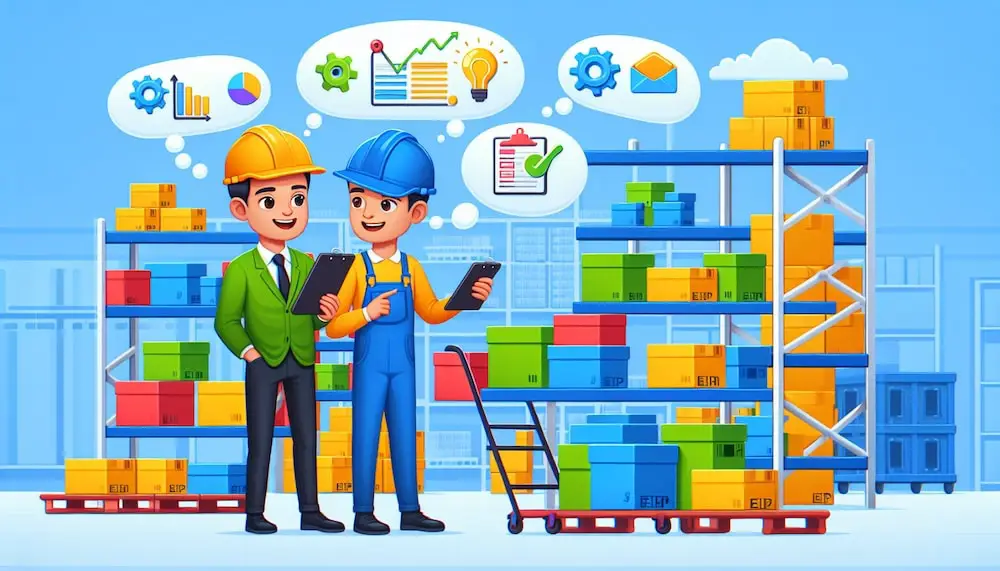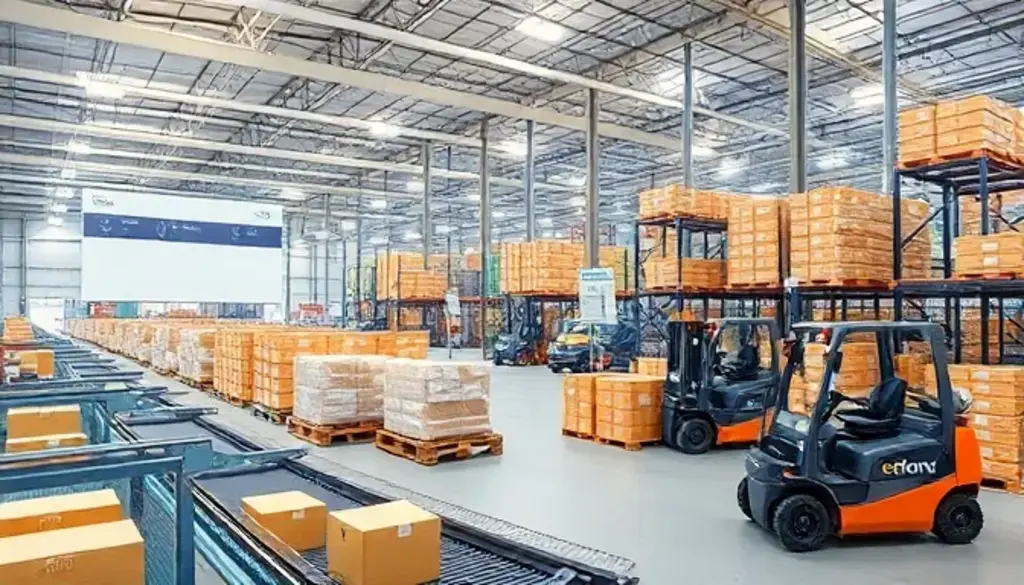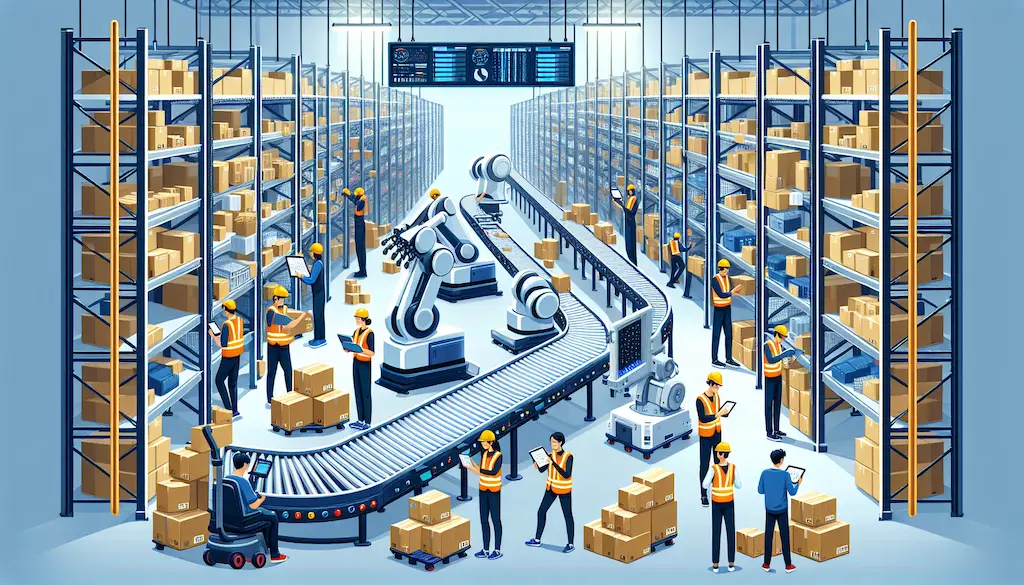
Want to know how integrating Enterprise Resource Planning (ERP) and Warehouse Management Systems (WMS) can transform your business? This guide will delve into the benefits of ERP WMS integration, from data accuracy to improved operational efficiency. Expect clear steps and practical insights to help you effectively integrate these systems.
Key Takeaways
- Integrating ERP and WMS systems boosts operational efficiency by streamlining workflows and automating processes.
- Real-time data synchronization between ERP and WMS minimizes errors, enhances data accuracy, and improves decision-making.
- Successful integration requires careful assessment of business needs, selection of the right tools, and thorough testing for a smooth transition.
Understanding ERP and WMS Solutions
To appreciate the benefits of integrating WMS and ERP systems, it’s essential to understand their core functions and how they differ.
A Warehouse Management System (WMS) is specifically designed to manage warehouse operations, such as inventory management, picking, packing, and shipping processes. It focuses on optimizing warehouse processes, offering real-time data and streamlined workflows that contribute to improved operational efficiency.
On the other hand, Enterprise Resource Planning (ERP) systems oversee broader business functions, integrating areas like finance, HR, and supply chain management. While both systems aim to enhance efficiency, WMS is dedicated to warehouse operations, whereas ERP encompasses a wider range of business processes.
Choosing between a WMS and an ERP—or integrating both—depends on your operational needs, the scale of your operations, and how well each system aligns with your business processes.
Key Benefits of Integrating ERP and WMS
Integrating WMS and ERP systems can offer transformative benefits for your business operations. From enhanced data accuracy and real-time insights to improved operational efficiency and cost savings, the synergy between these systems creates a unified platform that streamlines processes and optimizes resource utilization.
Enhanced Data Accuracy and Real-Time Insights
One of the most significant advantages of integrating ERP and WMS solutions is the improvement in data accuracy and access to real-time insights. By synchronizing data across both systems in real-time, you eliminate the need for manual data entries, reducing errors and ensuring that you always have accurate information at your fingertips.
For example, better inventory tracking enabled by this integration allows for more accurate demand forecasting, helping prevent issues like overstocking or stockouts. With automated data synchronization, businesses can generate reports and make informed decisions swiftly.
Improved Operational Efficiency
Operational efficiency is another key benefit of integrating an ERP and WMS. This integration streamlines workflows and automates processes, which reduces manual intervention and speeds up order processing.
For instance, when an order is placed, the ERP system sends the order details directly to the WMS. This seamless transition enhances task management and reduces errors, leading to quicker delivery times and higher customer satisfaction.
Cost Savings and Resource Optimization
A unified view of operations provided by ERP WMS integration can lead to significant cost savings. By optimizing warehouse processes and utilizing ERP data, businesses can reduce order fulfillment time and enhance order accuracy, which decreases carrying costs and minimizes financial losses.
Additionally, accurate inventory tracking and demand forecasting prevent overstocking and stockouts, leading to better resource management and cost reduction.
Related: How WMS and TMS Integration Can Boost Supply Chain Efficiency

How ERP Systems and WMS Work Together
Although ERP systems and a WMS serve different purposes, they work together harmoniously to enhance overall business efficiency. The ERP system automates business processes across multiple departments, while the WMS manages warehouse operations. Together, they ensure that business activities and warehousing processes align seamlessly, significantly boosting operational efficiency and accuracy.
Real-World Example: Streamlining Order Fulfillment with ERP WMS Integration
Consider a mid-sized distribution company that struggled with delays in order fulfillment due to manual data entry errors between their warehouse operations and business management systems. By integrating their ERP system with a WMS, the company synchronized order details and inventory levels in real-time, reducing errors and speeding up the fulfillment process. As a result, they achieved faster delivery times, improved customer satisfaction, and a 20% reduction in operational costs.
Steps to Successful ERP WMS Integration
Integrating ERP and WMS systems is a multi-step process that requires careful planning and execution. Here’s how to approach it:
Assessing Business Needs
Before starting the integration process, assess your business needs and define clear objectives. Determine whether you need a standalone WMS, an ERP system, or a combination of both. Evaluating these needs ensures that the chosen solution aligns with your business goals and operational processes.
Choosing the Right Integration Tools
Selecting the right integration tools is crucial for a seamless connection between WMS and ERP systems. Ready-made connectors and flexible tools like APIs or EDI can facilitate the integration process, ensuring compatibility with your existing systems.
Testing and Implementation
Thorough testing is essential to ensure that integrated systems function harmoniously before full-scale deployment. Conduct pilot tests to identify and resolve any issues, minimizing disruptions to your business operations. Implementing a phased approach during integration helps troubleshoot effectively and ensures a smoother transition.

Logimax: Powering Seamless ERP WMS Integration
At Logimax, we understand that the key to a successful ERP WMS integration lies in a solution that is both powerful and flexible. Our cloud-based WMS is designed to integrate effortlessly with leading ERP systems, creating a unified platform that enhances every aspect of your warehouse and business operations.
Tailored Integration Solutions
Logimax offers a range of integration tools, including APIs and ready-made connectors, that ensure seamless communication between your ERP and WMS. Our system is highly configurable, allowing you to tailor workflows and processes to match your unique operational needs. This flexibility ensures that your integration is not only smooth but also aligned with your business goals.
Real-Time Data Synchronization
With Logimax’s WMS, real-time data synchronization between your warehouse and ERP system is standard. This means inventory levels, order statuses, and other critical data points are always up-to-date across all platforms, reducing the risk of errors and enabling faster, more informed decision-making.
Scalability and Future-Proofing
As your business grows, so too can your ERP WMS integration. Logimax’s scalable solutions are designed to grow with your company, ensuring that your systems remain aligned and efficient as your operational needs evolve. Furthermore, our commitment to incorporating the latest advancements means that your integration is future-proofed, ready to take on the challenges of tomorrow’s marketplace.
Summary
Integrating Enterprise Resource Planning (ERP) systems with Warehouse Management Systems (WMS) offers numerous benefits that can transform your business operations. From enhanced data accuracy and real-time insights to improved operational efficiency and significant cost savings, the synergy between these systems creates a unified platform that streamlines processes and optimizes resource utilization.
Businesses looking to stay competitive in today’s dynamic market should seriously consider the integration of ERP with a WMS. By assessing your business needs, choosing the right integration tools, and carefully testing and implementing the integration, you can achieve substantial improvements in efficiency, accuracy, and customer satisfaction. With Logimax’s industry-leading solutions, you can ensure a seamless and scalable integration that unlocks the full potential of your business operations.
Ready to take your warehouse operations to the next level? Contact us today to learn how Logimax can help you integrate your ERP system with a powerful WMS for optimized performance and growth.
Frequently Asked Questions
What is the main difference between ERP systems and WMS?
The main difference is that a WMS focuses on optimizing warehouse operations like inventory and shipping, while an ERP system integrates various business functions across the organization. So, if you’re looking to manage warehouse tasks specifically, WMS is your go-to.
How does integrating WMS and ERP systems enhance data accuracy?
Integrating WMS and ERP systems boosts data accuracy by synchronizing information in real-time, reducing manual entry and minimizing errors. With everything updated automatically, you can always rely on having the most accurate data at your fingertips.
What are the cost benefits of integrating WMS and ERP systems?
Integrating WMS and ERP systems can significantly cut costs by streamlining warehouse operations, speeding up order fulfillment, and improving accuracy, which in turn lowers carrying costs and minimizes financial losses. It’s all about making your resources work smarter, not harder.
What steps should a business take to successfully integrate WMS and ERP systems?
To successfully integrate WMS and ERP systems, start by clearly assessing your business needs and defining objectives. Then, choose compatible integration tools and conduct thorough testing with phased implementation to ensure everything goes smoothly.



